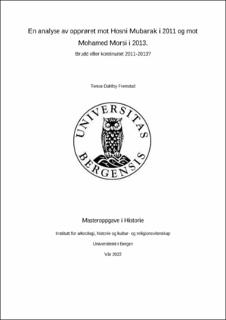| dc.description.abstract | This thesis aims to analyse the protests in 2011 against Hosni Mubarak and in 2013 against Mohamed Morsi. It all began when a wave of pro-democracy protests and uprisings started in Tunisia in 2010. This wave of protests and uprisings is known as “The Arab Spring”. When the Egyptian people saw what was possible in Tunisia, they got motivated to do the same. The protests against Mubarak started in January 2011, and in February 2011, he was removed from power. In June 2012, Mohamed Morsi became the first democratically elected president in the country after a chaotic transition characterized by conflict between Islamists and liberal opposition groups. However, it didn’t end here. One year after his inauguration, protesters went to the streets and demanded his removal. In July 2013, he was removed from power. In both cases, massive street protests resulted in military intervention and an end to the presidency. The most apparent difference between the two revolts was that the first was against a long-sitting dictator, while the second was against a democratically elected president. The overarching ambition of this thesis is to investigate the similarities and differences between the two protests, with a focus on the different actors involved. The actors I have chosen to analyse are the military, the state institutions and remains of the Mubarak regime, the Muslim Brotherhood, and the liberal opposition. By analysing how they acted from 2011 to 2013, I hope to answer whether it is most fitting to treat it as one long revolt or two different. To achieve this, I will split this period into smaller sections and analyse what happened in general and how the actors acted specifically. I argue that it makes the most sense to treat this as two different revolts, mainly because all the actors analysed didn´t take the same stance in 2013 as in 2011. The liberal opposition didn’t have enough power to decide the outcome alone. They depended on support from other groups, and who that was varied according to what paid off for themselves. The Muslim Brotherhood went from being a part of the revolutionary coalition, to focusing on winning power in elections, to having to defend themselves from protests. The military went from taking a neutral stance in 2011 to publicly show support to the protesters from the start in 2013. The remains of the Mubarak regime went from defending the government to mobilizing against it. This analysis has shown me that they all were opportunists who cared more about securing their own interests and position in future Egypt than the democratic process. | |
